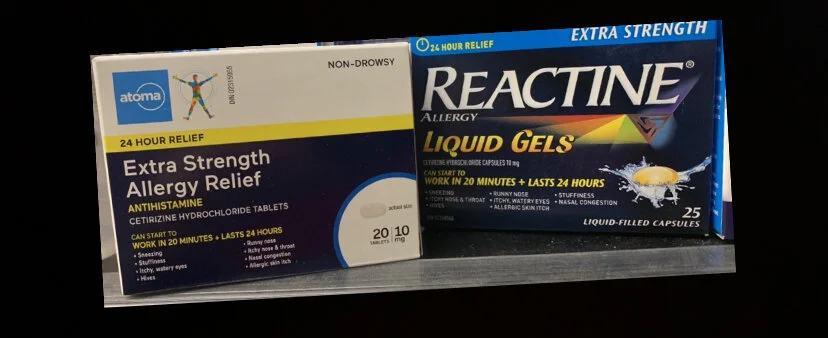Cetirizine (Zyrtec) in Lichen Planopilaris: Best Viewed as an Adjunct not Main Treatment
Cetirizine (Zyrtec) for Treating Lichen Planopilaris: Where does it fit in?
Antihistamines are increasingly being studied for the treatment for various types of hair loss. For the autoimmune disease known as alopecia areata for example, use of antihistamines like fexofenadine (Allegra) as well as others (i.e. ebastine) may have some treatment related benefits. In scarring alopecia. the use of antihistamines has only received a limited amount of study. Today, we will discuss the use of the antihistamine cetirizine for treating lichen planopilaris.
Lichen planopilaris is an immune medicated disease. There are a number of proposed mechanisms that lead ultimately to the disease. Cetirizine is an antihistamine medication and widely used for various types of allergy related symptoms. However, the medication may have a number of general and wide reaching effects on the immune system.
How does cetirizine work and how does it affect the immune response ?
Cetirizine is an H1 receptor antagonist. The drug minimally crosses the so called ‘blood brain barrier’ and so limited amounts actually get into the brain. This results in less sedation with cetirizine compared to any other traditional antihistamines. The 5 mg and 10 mg doses are unlikely to give sedation for most people. However, the 20 mg and 30 mg doses are much more likely to give sedation. There has been concern in recent years among long term chronic use of high doses of antihistamines on cognitive decline in patients so this needs to be taken into account when discussing high dose cetirizine as chronic therapy with patients with any medical condition.
Cetirizine has a number of potential effects to modify the immune response. These include
1. Inhibit DNA binding activity of NF-kappa B,
2. Inhibit the expression of adhesion molecules on immunocytes and endothelial cells
3. Inhibit the production of IL-8 and LTB4, two potent chemoattractants, by immune cells.
4. Induce the release of PGE2, a suppressor of antigen presentation and MHC class II expression, from monocyte/macrophages
5. Reduces the number of tryptase positive mast cells in inflammation sites.
The 2010 d’Ovidio Lichen Planopilaris Study
In 2010, d’Ovidio and colleagues studied the use of cetirizine at high doses. Rather than using 5 mg to 10 mg daily that is commonly use over the counter, the authors studied the benefits of 30 mg/daily. Twenty-one patients with lichen planopilaris (LPP) were treated with cetirizine as well as their topical steroids. in 18 or 21 patients (85.7 %) there was a reduction in redness, scaling and a reduction in extractable anagen hairs by the pull test. The authors reported that one patient developed cardiac arrhythmia after 3 months of successful treatment and dropped out of the study.
Cetirizine is an antihistamine and functions as an H1 receptor antagonist. In 2010, d’Ovidio showed that cetirizine at high doses (30 mg) could benefit some patients with lichen planopilaris. Over the counter antihistamine dosing like shown in the phone is 10 mg.
What are the side effects of cetirizine?
Side effects of cetirizine and other information can be found in our Handout.
Rare side effects including heart failure, angioedema and tachycardia. These side effects are rare at low doses such as the 5 mg and 10 mg (over the counter doses). Side effects increase as one increased the dose. The 30 mg dose used in the d’OIividio study would be expected to have a greater degree of side effects than the lower doses.
Conclusion
Cetirizine may have some benefit in treating lichen planopilaris. I sometimes prescribe cetirizine as an adjective treatment in patients with persistent itching and burning who are not fully responding to mainstay topical, intralesional and oral treatments. Generally I use 5 mg or 10 mg and only rarely do I prescribe 15-20 mg. I do not typically prescribe 30 mg doses as I find side effects increase greatly. One must respect the drug interactions and contraindications for the drug (as outlined in the handout). In many ways, I view cetirizine as a helpful add on - much the same way as I view the use of low level laser therapy in this disease. I do not think in the present day that cetirizine should find itself at the top of the therapeutic ladder but certainly has a place.
Reference
d’Ovidio R et al Therapeutic hotline. Effectiveness of the association of cetirizine and topical steroids in lichen planus pilaris--an open-label clinical trial. Dermatol Ther. 2010 Sep-Oct;23(5):547-52.
Namazi MR et al. Cetirizine and allopurinol as novel weapons against cellular autoimmune disorders.Int Immunopharmacol. 2004 Mar;4(3):349-53.
This article was written by Dr. Jeff Donovan, a Canadian and US board certified dermatologist specializing exclusively in hair loss.

